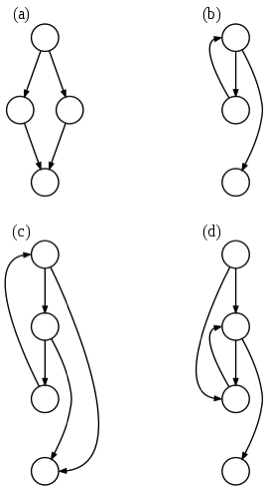
(a) an if-then-else
(b) a while loop
(c) a natural loop with two exits, e.g. while with an if...break in the middle; non-structured but reducible
(d) an irreducible CFG: a loop with two entry points, e.g. goto into a while or for loop
控制流图是代码的一种表征形式。
wiki:
Definition
In a control flow graph each node in the graph represents a basic block, i.e. a straight-line piece of code without any jumps or jump targets; jump targets start a block, and jumps end a block. Directed edges are used to represent jumps in the control flow. There are, in most presentations, two specially designated blocks: the entry block, through which control enters into the flow graph, and the exit block, through which all control flow leaves.[3]
Because of its construction procedure, in a CFG, every edge A→B has the property that:
The CFG can thus be obtained, at least conceptually, by starting from the program's (full) flow graph—i.e. the graph in which every node represents an individual instruction—and performing an edge contraction for every edge that falsifies the predicate above, i.e. contracting every edge whose source has a single exit and whose destination has a single entry. This contraction-based algorithm is of no practical importance, except as a visualization aid for understanding the CFG construction, because the CFG can be more efficiently constructed directly from the program by scanning it for basic blocks.[4]
Example
Consider the following fragment of code:
0: (A) t0 = read_num
1: (A) if t0 mod 2 == 0
2: (B) print t0 + " is even."
3: (B) goto 5
4: (C) print t0 + " is odd.” [jump targets]
5: (D) end program [jump targets]
In the above, we have 4 basic blocks:
A from 0 to 1, [entry block]
B from 2 to 3,
C at 4,
D at 5. [exit block]
A graph for this fragment has edges from A to B, A to C, B to D and C to D.
Reachability
Reachability is a graph property useful in optimization.
If a subgraph is not connected from the subgraph containing the entry block, that subgraph is unreachable during any execution, and so is unreachable code; under normal conditions it can be safely removed.
If the exit block is unreachable from the entry block, an infinite loop may exist. Not all infinite loops are detectable, see Halting problem. A halting order may also exist there.
Unreachable code and infinite loops are possible even if the programmer does not explicitly code them: optimizations like constant propagation and constant folding followed by jump threading can collapse multiple basic blocks into one, cause edges to be removed from a CFG, etc., thus possibly disconnecting parts of the graph.
Domination relationship
A block M dominates a block N if every path from the entry that reaches block N has to pass through block M. The entry block dominates all blocks.
In the reverse direction, block M postdominates block N if every path from N to the exit has to pass through block M. The exit block postdominates all blocks.
It is said that a block M immediately dominates block N if M dominates N, and there is no intervening block P such that M dominates P and P dominates N. In other words, M is the last dominator on all paths from entry to N. Each block has a unique immediate dominator.
Similarly, there is a notion of immediate postdominator, analogous to immediate dominator.
The dominator tree is an ancillary data structure depicting the dominator relationships. There is an arc from Block M to Block N if M is an immediate dominator of N. This graph is a tree, since each block has a unique immediate dominator. This tree is rooted at the entry block. The dominator tree can be calculated efficiently using Lengauer–Tarjan's algorithm.
A postdominator tree is analogous to the dominator tree. This tree is rooted at the exit block.
Special edges
A back edge is an edge that points to a block that has already been met during a depth-first (DFS) traversal of the graph. Back edges are typical of loops.
A critical edge is an edge which is neither the only edge leaving its source block, nor the only edge entering its destination block. These edges must be split: a new block must be created in the middle of the edge, in order to insert computations on the edge without affecting any other edges.
An abnormal edge is an edge whose destination is unknown. Exception handling constructs can produce them. These edges tend to inhibit optimization.
An impossible edge (also known as a fake edge) is an edge which has been added to the graph solely to preserve the property that the exit block postdominates all blocks. It cannot ever be traversed.
Loop management
A loop header (sometimes called the entry point of the loop) is a dominator that is the target of a loop-forming back edge. The loop header dominates all blocks in the loop body. A block may be a loop header for more than one loop. A loop may have multiple entry points, in which case it has no "loop header".
Suppose block M is a dominator with several incoming edges, some of them being back edges (so M is a loop header). It is advantageous to several optimization passes to break M up into two blocks Mpre and Mloop. The contents of M and back edges are moved to Mloop, the rest of the edges are moved to point into Mpre, and a new edge from Mpre to Mloop is inserted (so that Mpre is the immediate dominator of Mloop). In the beginning, Mpre would be empty, but passes like loop-invariant code motion could populate it. Mpre is called the loop pre-header, and Mloop would be the loop header.